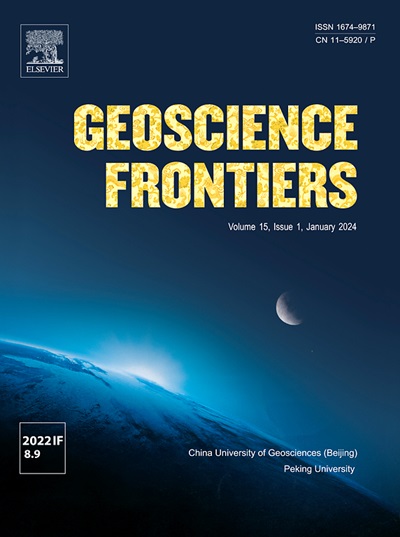碳捕获的未来:玄武岩在低水化二氧化碳封存中的作用
IF 8.9
1区 地球科学
Q1 GEOSCIENCES, MULTIDISCIPLINARY
引用次数: 0
摘要
减缓气候变化需要创新的解决方案,而碳封存技术处于最前沿。其中,玄武岩,一种富含钙、镁和铁的基性火山岩,通过矿物碳化作用成为二氧化碳(CO2)封存的有力候选者。这种方法将二氧化碳转化为稳定的碳酸盐矿物,确保永久和环保的存储解决方案。虽然大量的研究已经探索了玄武岩在高水化条件下的潜力,但在低含水量情况下尚未开发的前景仍然很大程度上未被探索。我们开创性的研究利用超临界CO2 (sc-CO2)研究了玄武岩粉末在低水条件下的矿物碳酸化。我们的实验在50°C和15 MPa下进行,控制水分含量为30%,实验跨越了不同的时间点(0,7,14,21和28天)。利用先进的x射线衍射(XRD)和扫描电子显微镜与能量色散x射线能谱(SEM-EDS),我们揭示了矿物学和形态的转变。结果是惊人的:即使在低水条件下,玄武岩也能有效地形成有价值的碳酸盐矿物,如方解石、菱铁矿、菱镁矿和铁白云石。碳酸化效率随时间的变化而变化,反映了玄武岩基质的动态变化。这些发现为优化低水合作用下玄武岩中的二氧化碳封存提供了关键见解,标志着可持续碳捕获和储存的重大飞跃。本文章由计算机程序翻译,如有差异,请以英文原文为准。

The future of carbon capture: Basalt’s role in low-hydration CO2 sequestration
Mitigating climate change demands innovative solutions, and carbon sequestration technologies are at the forefront. Among these, basalt, a mafic volcanic rock packed with calcium, magnesium, and iron, emerges as a powerful candidate for carbon dioxide (CO2) sequestration through mineral carbonation. This method transforms CO2 into stable carbonate minerals, ensuring a permanent and environmentally safe storage solution. While extensive research has explored into basalt’s potential under high hydration conditions, the untapped promise of low water content scenarios remains largely unexplored. Our ground-breaking study investigates the mineral carbonation of basalt powder under low water conditions using supercritical CO2 (sc-CO2). Conducted at 50 °C and 15 MPa with a controlled moisture content of 30%, our experiment spans various time points (0, 7, 14, 21, and 28 days). Utilising advanced X-ray diffraction (XRD) and scanning electron microscopy with energy-dispersive X-ray spectroscopy (SEM-EDS), we unveil the mineralogical and morphological transformations. The results are striking: even under low water conditions, basalt efficiently forms valuable carbonate minerals such as calcite, siderite, magnesite, and ankerite. The carbonation efficiency evolves over time, reflecting the dynamic transformation of the basalt matrix. These findings offer pivotal insights into optimising CO2 sequestration in basalt under low hydration, marking a significant leap toward sustainable carbon capture and storage.
求助全文
通过发布文献求助,成功后即可免费获取论文全文。
去求助
来源期刊

Geoscience frontiers
Earth and Planetary Sciences-General Earth and Planetary Sciences
CiteScore
17.80
自引率
3.40%
发文量
147
审稿时长
35 days
期刊介绍:
Geoscience Frontiers (GSF) is the Journal of China University of Geosciences (Beijing) and Peking University. It publishes peer-reviewed research articles and reviews in interdisciplinary fields of Earth and Planetary Sciences. GSF covers various research areas including petrology and geochemistry, lithospheric architecture and mantle dynamics, global tectonics, economic geology and fuel exploration, geophysics, stratigraphy and paleontology, environmental and engineering geology, astrogeology, and the nexus of resources-energy-emissions-climate under Sustainable Development Goals. The journal aims to bridge innovative, provocative, and challenging concepts and models in these fields, providing insights on correlations and evolution.
 求助内容:
求助内容: 应助结果提醒方式:
应助结果提醒方式:


